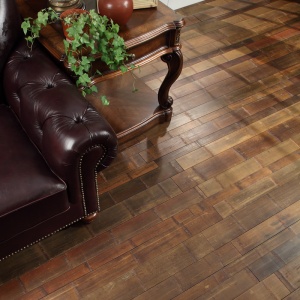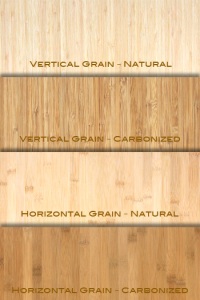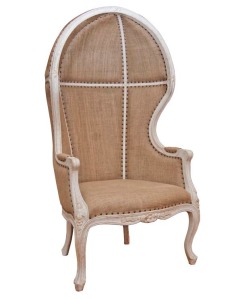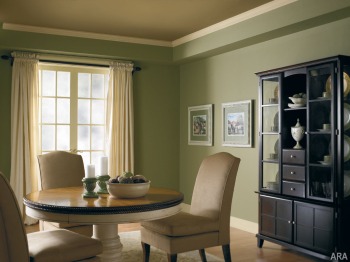Designology
More than just interior design…
Unfurled Bamboo
It looks like bamboo might be back again in a big way. Not that it ever really left however with such a liner looks it has up until now been mostly used in contemporary and modern style homes and offices. I recently did a search on bamboo flooring to see what “new” things might be out there and amongst all my findings I saw something that really stood out… “unfurled bamboo”. My curiosity got the best of me. I clicked on a link from Dasso (http://www.dassoxtr.com) and discovered the little gem that is unfurled bamboo.
Imagine my surprise when I saw what a traditional and even vintage look “unfurled bamboo” gives. What is so amazing about bamboo is not just its characteristics but it’s renewable qualities. Most think bamboo is a wood but it is technically a grass. There are over hundreds of species of bamboo and just like with trees they all have their own interesting traits. Moso bamboo which is the vartiety most often used for floors can grow over 3′ in a day. It takes 3-5 years to fully mature and be harvested. One of the best parts about bamboo is that unlike trees when they get harvested the root system is left intake so it simply keeps growing.
Bamboo has been present in the flooring industry since the early 90’s and has grown and changed since then. A lot of the changes having to do with the addition of laminates, resins and other binding agents, styles and color. There have been 3 generations of bamboo flooring:
The first type of bamboo flooring we saw was in laminated bamboo stripes that were in the form of the round bamboo stalks. They were cut into approximately 1/4″ strips and laminated together to form the plank. These were in the natural yellow color of the bamboo but also released was a caramelized version which was actually bamboo that had been steamed. The market place also only saw 2 types: vertical grain and horizontal grain. This flooring was sold as being harder than oak but in actuality it was not and dents were noticeable.
The second type of bamboo flooring introduced was the strand woven. The stalks were still cut the same however the difference was that they were also partially shreds in order to expose the underlying bamboo fiber. Resins were prior to subjecting the bamboo to enormous amounts of pressure which resulted in a denser and hardier product. The introduction of tiger hue (a mix of the natural and caramelized shades) came about as well as giving customer’s the option of having their bamboo stained before the top coat was added.
The third (and my favorite) type of bamboo flooring introduced is current wonder that is unfurled bamboo. A company by the name of Dasso created a product called EcoSolid which is an unfurled bamboo that was created using a patented manufacturing process that “flattens” out one bamboo stalk into one piece. With this process the hardest part of the bamboo stalk (which is the outer skin) can be used for an amazing flooring surface. “The EcoSolid Forest collection boasts an impressive natural look because no lacquers, polyurethanes or waxes are used on the surface, which is the actual skin of the bamboo as it comes from nature. The Vintage collection adds another element to the EcoSolid line by incorporating rich colors into a smooth, UV-finished face.”
This is thus far my favorite and I for one can’t wait to use it in a client’s home!!
Check out Dasso’s partner for this amazing bamboo product: http://www.ecotimber.com
http://www.ecotimber.com/product-collection?skugroupid=301&title1=42&title2=Dasso.Flooring
Special thanks to Floor Trends Mag for their brilliant research and wonderful information shared about on going trends in flooring. http://www.floortrendsmag.com/articles/96805-the-continuing-evolution-in-bamboo-flooring?v=preview
Christmas Beauty
It’s that time of year again. Time to gather all your family, friends and take in the good ol’ Christmas spirit. Time for giving, extra loving and warming yourself by the fire. With that in mind I leave you with some beautiful Christmas decorations as found around the net world. Enjoy and stay warm!
– C

FROM: http://www.hosowo.com

FROM: http://www.countryliving.com

FROM: http://cdn.sheknows.com

FROM: http://3.lushome.com

FROM: http://www.examiner.com

FROM: http://cdn.freshome.com

FROM: http://www.treeinggear.com

FROM: http://www.tiyboc.com
Tansu…Japanese for awesome?!
I had never heard the name “Tansu” until this morning when meeting with my client (also my mother in law…ha ha). We are trying to find an interesting chest for her entry and I suggested what I called “one of those stacked drawer/latter chests” and she said “you mean a Tansu Chest?” As a designer I should of course know everything about design right?! We’ll that would be great but with so many beautiful pieces of furniture, artwork and other design terms this one seemed to slip past me.
What exactly is a “Tansu” you might ask…in case my discription didn’t help, a “tansu is the term given to the antique cabinetry of Japan made principally between 1860 and 1910, the bulk of the Meiji period. Developed from the Japanese need for storage that would not clutter their small living spaces, most tansu are portable chests made to be kept in storage lofts or kuras (fireproof storehouses). A dramatic combination of utility and beauty, each piece carries a unique history. Its careful construction conveys the region of origin, intended use, its owner’s status, wealth, and often profession. From samurai sword chests to merchants’ sea chests, from inventory chests to kimono chests, from mizuya (kitchen tansu) to cha-do (tea tansu), tansu dominated Japanese furniture design until western influences swept Japan at the beginning of the 20th Century.” (http://www.shibui.com/Products/Tansu)

Tansu Step Chest (http://antiques-furniture-chinese.com/Tansu-Chests/Antique-Wooden-Furniture-Tansu-Chest-GJf-1145.html)
Currently these helpful beauties are mass produced as well as still imported from it’s original place of origin, Japan. Pricing ranges any where from $300.00 to $3,000.00 depending on if it is “real” or not. If you are lucky you might be able to find an authentic one and not break the bank but in the mean time check out your local swap meets and antique stores. If desperate, cheap versions can be found online. There are even variations of them that are very trendy as they have a more contemporary look. Either way which ever you chose they are very charming and handy pieces of furniture and I’m glad I now know it’s name. 🙂
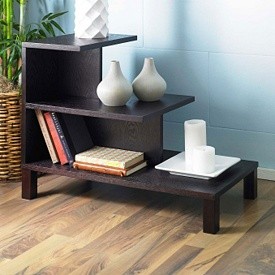
Variation of a Tansu Step Chest (http://www.kaboodle.com/reviews/tansu-step-table-1591-46598-0375)
Teak + Tile = LOVE
A current obsession of mine is something I newly discovered and that is TEAK TILES. I have always loved the idea of tile covering an entire wall but it can be both expensive and risky. If not selected carefully it could look busy and/or it could be following a trend that won’t last. It’s always hard to know if what you currently like is something that will stand the test of time or not. With that being said I hope and think teak tiles will.
Jakarta Teak Mosaic Tiles are the newest and hottest tiles going. These wall tiles are an incredibly unique and fresh approach to eco friendly products. Made from reclaimed Teak wood, low VOC resins and sustainably harvested wood backer, they are perfect for kitchen design and bathroom design. Teak tiles can be used in commercial design, as kitchen tiles or bathroom tiles. Modern, tropical, rustic and gorgeous. Go eco, go tropical, go stunning!
Reproduction beauty…
This chair which from MK Home Furnishings is a reproduction of a French Regency period piece is sooo beyond drool worthy. I am hoping one day that a client will want this in their home. If not I will have to find a place in my own home to use it.
Solid wood vs. Engineered wood vs. Lamintate
While combing the internet I came across this article and HAD to share!! Hopefully this will help a lot of people to know the differences between these 3 products and more importantly the pros and cons of each! ENJOY!
– Christine
http://www.distinctiveliving.com/solid-wood-vs-engineered-wood-vs-laminate-the-battle-royale/
Solid Wood vs. Engineered Wood vs. Laminate: THE BATTLE ROYALE
In this corner, composed of 100 percent wood, priced at $3 to $10/square foot, and adding as much as $10,000 in value to the value of your home is… hardwood. In another, consisting of fiberboard and a durable wear layer, priced at $3 to $7/square foot, but adding considerably less value to your home is… laminate. And in still another, boasting elements of pure wood coupled with almost as much stability of laminate is… engineered wood. Each has its positive and negative attributes. Before outfitting your home in one over another, it’s important to understand the differences. Only then can you make a truly informed decision regarding what material is right for you. Durability depends more on the finish one puts on the base wood than the makeup of the base itself.
Solid Wood
Solid wood floors are just that — 100 percent solid wood. Not only are they stunning and elegant but they’re also one of the best ways to increase a home’s value. In fact, a recent survey of U.S. realtors revealed that installing hardwood floors can increase your home’s value by as much as $10,000!
Wood floors are versatile — they can complement virtually any aesthetic — provide acoustic insulation, and can be refinished multiple times. They only improve with age, as solid wood acquires a desirable shine over time. Solid wood is among the longest lasting of all flooring types but normally cannot be installed directly over concrete. However, the flooring expands and contracts due to changes in humidity. The wider the wood the more expansion or contraction will occur. Although installers try to compensate for this movement by leaving an expansion gap between the floor and the wall, most experts agree that you may be better off going with engineered wood for kitchens, bathrooms or laundry rooms.
Engineered Wood
Engineered wood has a top layer of solid wood, which varies in thickness, depending upon the quality; the balance is high quality layered hardwood. They’re available either unfinished or pre-finished in a range of colors and provide the same design flexibility and style as solid wood; unfortunately, they also carry the same price tag. The better makes of engineered wood have a slice cut face and are longer, up to 7 feet in length.
Although all hardwood floors will expand and contract due to moisture, engineered wood fares much better. And while solid wood floors may expand or contract slightly with age, engineered floors won’t. All things equal, engineered flooring has a slight advantage over solid — particularly in regions where humidity changes are a constant, as they’re dimensionally stable. In addition, they may be installed above, on, or even below ground level.
However, unlike solid wood, some engineered wood floors can only be refinished once or twice. Others cannot be refinished at all. The deciding factor is the thickness of the wear layer. In addition, it’s arguable whether engineered wood will increase the value of your home as much as solid wood.
Prefinished or Custom
Once you’ve decided upon solid or engineered wood, your next dilemma is pre-finished or custom. Pre-finished wood arrives at your home ready to install. Custom wood flooring, on the other hand, is installed, sanded or scraped, and finished on site. It affords homeowners the opportunity to create something truly unique — something no other homeowner could replicate. With custom wood flooring, you can create a one-of-a-kind floor that reflects your family’s personal taste. You pay for this specialization, of course, but for truly distinguishing tastes, there’s nothing like custom wood.
Laminates
Laminates consist of a base, usually mdf or hdf fiberboard, topped with a print and then a wear layer. They’re usually cheaper, and make excellent do-it-yourself projects, as they’re easy to install. Many are installed by placing interlocking boards over a layer of foam, which prevents buckling in the floor and absorbs sound. Laminate floors are extremely durable, scratch-resistant, and long-lasting.
However, laminates cannot be refinished or recoated, add less value to your home than solid or engineered wood and, quite simply, don’t have the same “character” as wood. Thanks to a pre-printed pattern, some (or maybe all) of the boards may appear identical. But the best quality laminates can result in beautiful floors that really do have the appearance of hardwood flooring.
And the Winner Is…
On pier and beam construction: A solid wood floor.
On Slab construction: An engineered wood floor
For a quick and inexpensive option: Laminate floors
Cost aside, most experts believe that engineered hardwood is the way to go. However, both solid and laminate woods have their own positive and negative attributes. One thing’s for certain — there’s nothing quite like the look of hardwood floors to give beauty and distinction to a home.
Why Not Go Green This Fall?
(ARA) – When you think of the colors associated with fall, green doesn’t necessarily come to mind. Environmentally speaking, however, it should. There’s no better time than now to lessen your home’s impact on the environment and change the way you decorate and live. So, why not go green this fall? It’s not nearly as difficult to become earth-friendly as you might think.
“From products that contribute to good indoor air quality to ones that truly reflect the ‘reduce, reuse, recycle’ mantra, the number of affordable green interior decorating products has literally exploded within the past five years,” says Donna Schroeder, Dutch Boy color marketing and design manager.
These days, you can find stylish, eco-friendly design elements for every room in the house. And, contrary to popular belief, going green doesn’t mean you have to sacrifice style for sustainability. The two can coexist quite effortlessly.
You can start simple by dressing your bed in luxurious sheets, throws and comforters made from fabrics such as rich, renewable bamboo or soft, organic cotton. Cover your floors with formaldehyde-free carpets constructed of recycled fibers or select a natural material, like stone, slate or even concrete. Then, hang energy-efficient window treatments with high insulation and shading properties.
Don’t stop there. Spice up your tired sofa with a design-forward slipcover and throw pillows crafted from 100 percent recycled materials. Add bright recycled glass plates and serving pieces to your china cabinet. Buy furniture made from sustainably harvested wood or, better yet, visit local secondhand shops and repurpose. Or, look around your own home and see what you already have that can be adapted for a new use. You’d be surprised what a little creativity and some good old-fashioned elbow grease can do.
If you’re looking to add bold, fun color, paint fits perfectly into this overall green scheme. It’s an inexpensive, effective and, most importantly, environmentally-minded way to change the look and feel of an entire room. Many paint manufacturers now offer coatings that contain few, if any, volatile organic compounds (VOCs), or vapors that are released from paint as it dries.
Using paints formulated without VOCs, such as Dutch Boy’s new Refresh interior paint with exclusive odor-eliminating Arm & Hammer technology, takes your home one step closer to reducing your environmental impact while leaving your interior looking fresh, modern and filled with personality.
Many home improvement products, including Refresh, are also Indoor Air Quality certified by The GREENGUARD Environmental Institute, a nonprofit, industry-independent organization that certifies indoor products that meet satisfactory indoor air emissions standards.
Keep in mind that greening your home, inside or out, doesn’t happen in a matter of minutes or even overnight. It’s an ongoing process. The limit to how green your home can be is up to how willing you are to adjust your lifestyle. The choice is yours. “It doesn’t take any grand gestures to start going green,” Schroeder says. “Tiny changes add up to make a big overall impact on the environment.”
Courtesy of ARAcontent.com

